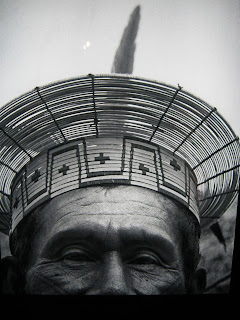February has almost come to an end, and the blogger knows time is running out! But February this year has also been the month of the carnival, when everything in Rio simply stops to let the the bands and the participants march and dance for a week. The blogger, going on fifty, decided a long time ago that carnival was great, but once or twice was enough! Nowadays, a few days to just rest and take it easy is carnival my way.
It is well-known that in Brazil the new year only starts after carnival, and that pretty much sums up the last week. It is time for 2016 to start! Time for museums to open up again, and I decided to check out the Museu do Indio - The Museum of the Indian in Botafogo. Housed in an old mansion built in the 1880's it is a cultural an scientific agency for FUNAI - the National Foundation of the Indian. It was created by Darcy Ribeiro in 1953, and that should have been reason enough for me to have visited the museum a long time ago. Darcy Ribeiro was a Brazilian anthropologist, and his books have been very important in my quest to try to understand Brazil.
It was a scorching afternoon, but the garden surrounding the museum was green and inviting, and, fortunately, the old mansion had great air conditioning. There were several exhibits I started by the one called " Miçangas".
Miçangas or glass beads are used among the Indians to produce jewelry, art, headgear, and ritual clothing. Even if many tribes used seeds of different kinds before the Europeans came and offered the glass beads, in order to trade them for other more precious goods, most of them were fascinated by the glass beads and incorporated them in their traditional creations.
The exhibit is beautiful, with videos, interactive devices and the stories behind the different artifacts, but unfortunately there is no information in English.
I was fascinated by these delicate bowls.
And how can one not be impressed by this incredible outfit?
The exhibition also shows how the glass beads have traveled all over the world, and how they are used in many cultures.
This is an example from Brazil, but glass beads are used in the national costumes in my native Norway, as this picture shows.
But there was more to see! After visiting the little store that sells objects made by many different tribes, I went on to see the exhibit called: "Ashaninka - O poder da beleza" This exhibit about the myths and the beauty of the Ashaninka people who live in the Amazon in Brazil and Peru was completely different but just as interesting.
I came out in the sunshine again and thought about the fact that I know so very little about the Brazilian Indians. They live all over Brazil, but are not very present in the Brazilian society. The museum has the objective of promoting an accurate and updated image for the indigenous cause, while avoiding common misconceptions and prejudice of these societies. There is still a long way to go in Brazil, where the Indian people are still fighting for their rights.
The statue of General Rondon who created FUNAI, and was responsible for creating a new political respect for the Brazilian Indians, is symbolically merged with a statue of an Indian. It seemed to me that this statue represented the spirit of the museum, and from the garden Christ -The Redeemer, watching over it all, could be seen. It was time to head home.























Nenhum comentário:
Postar um comentário